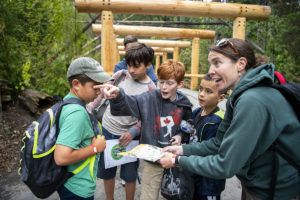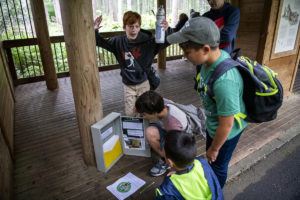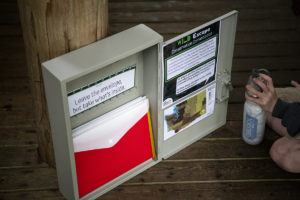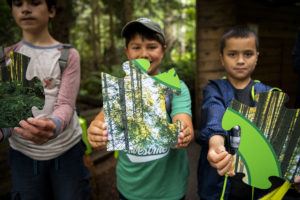Six heads bent over a piece of paper on the Northwest Trek path. The atmosphere was intense.
“All right, team – our first mission is Bears,” said Lauren Bentson, camp director at the Tacoma Nature Center. “That’s where our clues are, and our lockbox. Do we have a name?”
“El Panthero!” called out one of the group. Others nodded.
“Okay,” said Bentson. “Are you excited?”
“Yeah!” came the reply.
For the Wildlife Biologist campers from the Nature Center, it was time for a Wild Escape.
Escape Rooms without walls

“Wild Escape is a new program for kids or adults to learn about nature and solve a puzzle at the same time,” explains Emily Santiago, lead naturalist at Northwest Trek. “It’s all about teamwork.”
Kind of like an open-air escape room puzzle, Wild Escape asks participants to explore one area of the park at a time: canines, cats, birds, bears or forest/wetland animals. At each area, answering a series of nature questions correctly yields a numerical code that opens a lockbox containing the next area’s questions, a giant acrylic puzzle piece and a “conservation conversation” starter question.
When all the area lockboxes have been opened, the puzzle pieces fit into a giant reward and – hopefully – the group has collectively found the answer to the big Wild Escape question: How can we make a difference for wildlife?
Down at the black bear viewing deck, the El Pantheros were well on the way to solving the first part of the puzzle, after spotting a Douglas squirrel and bison on the way.
Learning about animals

“Okay, question one,” began Bentson. “’Why do you think brown bears near the coast are bigger than grizzlies in the forest?’”
The four campers, all boys aged 10-12 and all passionate about nature, began a lively discussion about the multiple choice answers.
“Answer 4 is ‘so they can climb trees more easily,’” read Gabriel.
“No, they don’t climb trees!” shot back Liam.
“I think it’s 2 and 3,” concluded Joseph.
The second question – what behavior grizzlies have that requires longer claws than black bears – saw agreement on two easy wrong answers, but some indecision on the other two.
“Shall we observe the bears and see if we can get any clues that way?” suggested Bentson.
“Or we could try one number, then do the other if that one doesn’t work,” Lee pointed out logically.
Solving the puzzle for wildlife

A final true/false question – whether there is evidence that using bear organs as medicine has any effect at all – and then Joseph was punching in code numbers.
The flat green box clicked open.
“Yeah!” shouted everyone in unison.
Out came a puzzle piece, and the question paper for the next mission – the Forest/Wetland habitat.
“Hey, here’s the conservation conversation,” said Joseph, peering into the box. “’Should grizzly bears be reintroduced into their natural range?’”
“What’s ‘natural range’?” asked Gabriel, and Bentson explained.
“I think yes,” said Liam. “Because if that’s the area they should live naturally, it’s going to be able to support more of them.”

“Do we all agree?” asked Bentson.
Solemn nods all round. Then Gabriel gave a little leap.
“We cracked the code!” he cried, gleefully.
“Good job, you guys,” agreed Bentson, with a grin. “That was awesome!”
And after some intense map consultation, the El Pantheros set off up the path to their next mission.
LEARN MORE: Find out about Wild Escape on our Field Trip or Group Events pages.